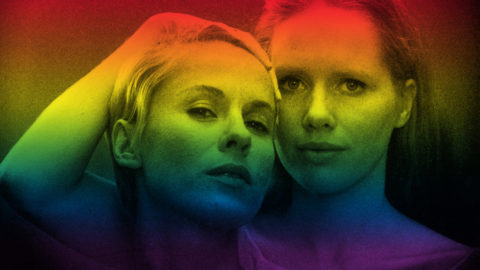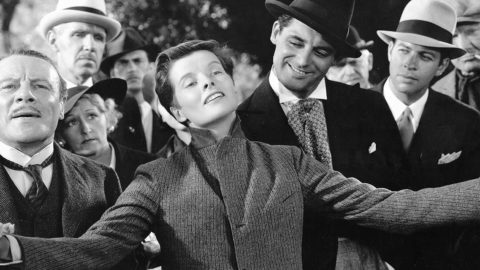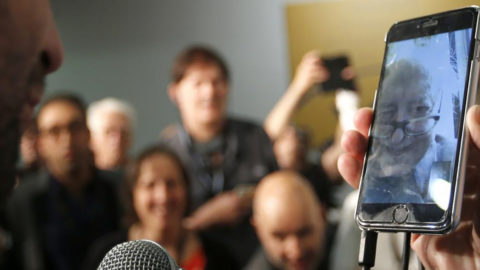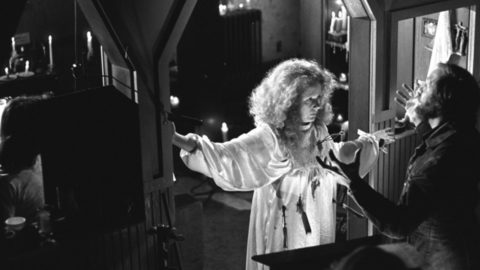Queer and Now and Then: 2002
In this biweekly column, Michael Koresky looks back through a century of cinema for traces of queerness, whether in plain sight or under the surface. Read the introductory essay.
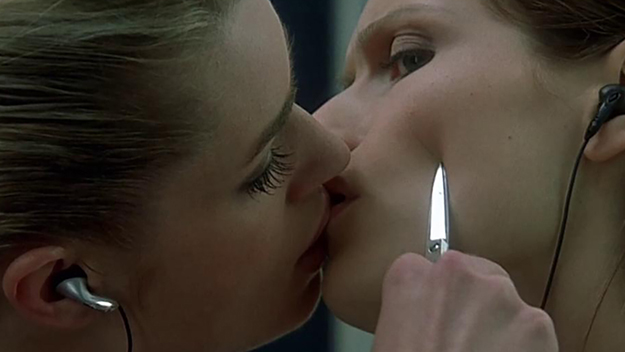
Femme Fatale (Brian De Palma, 2002)
For a director whose cinema would seem straight as a razor, Brian De Palma’s films radiate an undeniable queer energy. This unrepentant male gazer is perhaps an odd candidate for queer study, yet there are multiple avenues worth exploring that could help explain how De Palma has managed to penetrate the consciousness of many a gay viewer, this one included. I can name at least 10 gay-identifying critics off the top of my head who are entrenched fans, and I would argue that the intense appeal his films hold for us goes beyond visual voluptuousness or camp—though such matters are not incidental—and into a deeper, subconscious realm that rejects fixed identities, embraces marginalization, and acknowledges the integrity, even the necessity of social performance. De Palma’s dream states—and his dreams-within-dream states—are not merely alternate realities; they represent lives outside of normative functions. The false, bottomless narratives of some of his best thrillers—Sisters, Dressed to Kill, Body Double, Raising Cain, Femme Fatale, Passion—contribute to an outrageous kind of sensuousness that short-circuits cognitive, linear reality.
Rare is the De Palma movie that prizes or reifies standards of normalcy, heterosexual or otherwise. There is a radical empathy at work, for instance, in Carrie (1976), which encourages identification with an ostensible “monster,” making it all but impossible to feel a deep, nearly spiritual connection to a mercilessly bullied outcast. Even Dressed to Kill (1980), a film that could easily be tagged as transphobic, functions on an emotional gut level primarily because it engenders sympathy for all of its main characters, each of whom is socially marginalized and thus in one way or another exists outside of traditional, progressive roles: Angie Dickinson’s sexually starved housewife, Nancy Allen’s persecuted sex worker, Keith Gordon’s lonely teen geek, and, most importantly, Michael Caine’s killer psychiatrist, whose trans identity, in the film’s crass, hothouse B-movie logic, is akin to a murderous split personality disorder, an extreme, R-rated riff on Norman Bates. Employing and slyly parodying Psycho’s psychiatric diagnosis, Dressed to Kill is an uncloseted, unbound film that exists at the intersection of various characters’—and viewers’—erotic fixations. Perspective is of paramount importance in De Palma’s films, not just because of the complex networks of who’s looking and who’s being looked at but also for the ways in which we are invited to experience desire right along with the people onscreen.
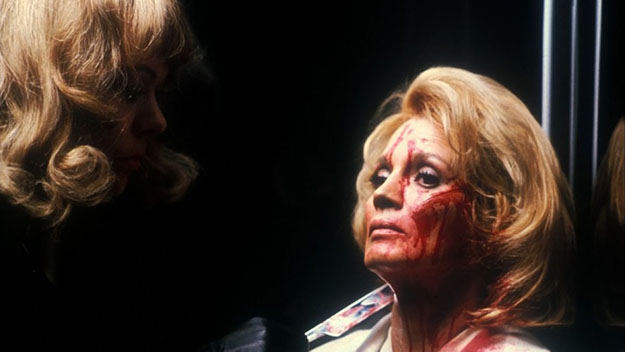
Dressed to Kill (Brian De Palma, 1980)
I’ve long found Femme Fatale to be De Palma’s queerest film, both for explicit narrative reasons and for something more connected to aesthetic perspective. The exhilaration of his 2002 thriller comes from its constant, absolute awareness of sex and identity as performances and the manner in which it unabashedly, knowingly lures the viewer into its world of luxurious game playing. In De Palma’s films, desire becomes spectacle, an unavoidable and somewhat serious extension of the director’s oft-reiterated belief that people go to the movies to watch women. “People have been looking at beautiful women since the beginning of time,” he shrugged to an interviewer at the time of Passion’s release in 2012. “All you have to do is look on your television screen or go Googling or pick up a magazine, and what do you see? Women, dressed or undressed. That’s what people are interested in.” He’s intractable on the point of visual pleasure and for decades has played enough variations on this theme to make it both persuasive and surprisingly rich. Femme Fatale doesn’t shift perspective away from De Palma’s fixations, but it so perversely and continually looks back at itself, refracting, shattering, and reconstituting its own gaze—and its characters’, and ours—that it effectively queers itself in the process.
Its sinuous, virtuosic, 20-minute opening heist sequence creates layers upon layers of thrilling distancing effects and narrative conceits, a labyrinth of desire that reminds the viewer of the inherent eroticism of cinephilia itself. Going beyond mere self-referentiality, Femme Fatale foregrounds from the beginning the displacement of sex onto the love of movies, and how we fashion and create and re-create identities based on that love. The first shot dissolves the relationship between viewer and screen: a French-subtitled version of Billy Wilder’s Double Indemnity (1944) plays on a hotel room television, the reflection of a reclining, nude woman intently watching it made visible on the glass. We’re thus instantly aligned with this mystery woman’s point of view—like her, we’re watching a screen—at the same time that her image in this literal movie-mirror makes her also the object of our gaze. After Barbara Stanwyck shoots Fred MacMurray, a steely-eyed man—her accomplice, played by Eriq Ebouaney—enters the room and angrily turns off the TV to prep her for the night; at the end of the scene, he slides open the room’s curtain to reveal nothing less than the glittering, flashbulb-lit red carpet of the Cannes Film Festival, the international standard-bearer for immersive, tail-swallowing movie glamour.
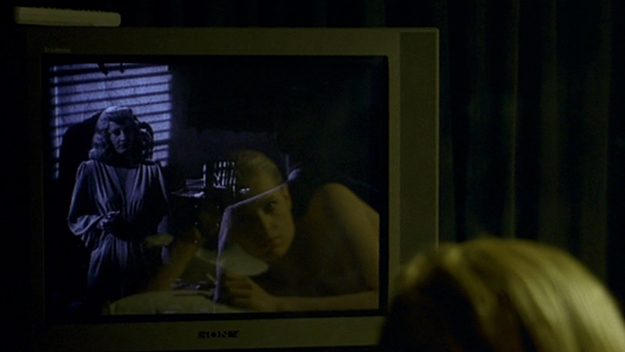
Femme Fatale (Brian De Palma, 2002)
Laure Ash, our guide through this cinema-besotted world, played with sharklike dedication by Rebecca Romijn—at the time credited as Romijn-Stamos—may have been re-viewing Double Indemnity not just for pleasure but for research; preparing for a major jewel heist at the most intently watched film event in the world, Laure is possibly getting into character, with Stanwyck’s tough-as-nails Phyllis Dietrichson as inspiration. Later she’ll even quote her directly, as though knowingly constructing herself from bits and pieces of other femme fatales, thus acknowledging herself as a character and a composite. Infiltrating the red carpet, disguised as a paparazzo—of course, because all De Palma heroes have to have a profession, even a fake one, in which they must look or listen—Laure, her short blonde hair boyishly slicked back, fixes her sights on Veronica, a beautiful model, played by Rie Rasmussen, draped in a preposterously pricey top made entirely of Chopard diamonds. The two exquisite, statuesque women exchange a sultry glance and soon enough, Veronica is accompanying Laure to the ladies’ room, where, during a bout of heavy petting in the bathroom stall, Laure begins to remove Veronica’s 10-million-dollars worth of jewels one by one, and, in a hilariously low-rent scheme, passes them under the gap to the adjoining stall, where Ebouaney is waiting to exchange them for glass fakes.
If the heist plot would seem to be based on Veronica’s complete cluelessness and/or susceptibility to erotic attention, De Palma eventually has an answer for that, punishing us for our assumptions as well as our own propensity for erotic distraction. To criticize the women’s lesbian encounter as softcore gratuitousness is entirely correct—and entirely the point. This first sequence is all about distraction: largely wordless, captured by a smoothly roving camera, and set to Ryuichi Sakamoto’s endlessly looping, sensuous riff on Ravel’s “Boléro,” the bathroom heist is intricately intercut with what’s going on in the rest of the Palais. Laure’s other partner, played by Edouard Montoute, is able to sneak into the building’s air shaft and down to the subterranean control room because the male security guards are too busy salivating over Veronica’s red-carpet look; meanwhile, in the theater itself, the world premiere of middlebrow French prestige pic East/West (1999) is preoccupying a packed festival crowd from what’s going on behind the scenes, including the actual film’s star Sandrine Bonnaire and director Régis Wargnier, playing themselves. The games of distraction continue, as Wargnier can barely concentrate on his own movie since girlfriend Veronica seems to have been in the bathroom an awfully long time, her empty seat conspicuous beside him.
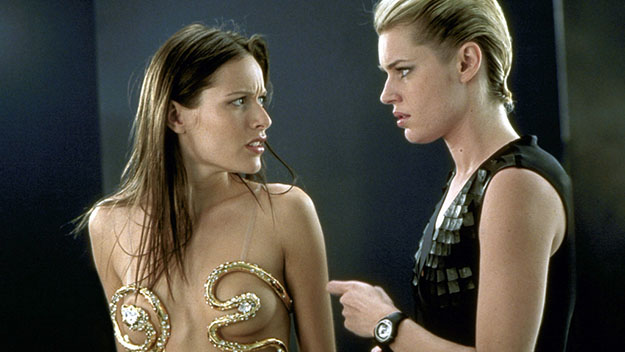
Femme Fatale (Brian De Palma, 2002)
While Veronica puts on a good show of shock and outrage about the switcheroo, Laure makes off with the jewels, double-crosses her partners, and, in an attempt to elude their wrath as well as the authorities, finds herself in a fortuitous position: fate has put a doppelgänger in her path, a suicidal, missing Parisian woman whom she is mistaken for, and whose identity she summarily assumes. How De Palma glides through these narrative points, which build upon one another with exhilarating absurdity, makes for perhaps the most purely enjoyable filmmaking of his entire career. Enhancing the patently insane, constantly self-referential, yet entirely singular plotting is the presence of glamazon Romijn, who, outfitted with a series of unconvincing disguises—wigs, identities, and a shaky French accent—functions as both sexpot and drag queen. This could partly explain why Femme Fatale is one of the few movies that has, in my experience, consistently appealed equally to the libidos of tongue-wagging straight guys and tickled the pleasure centers of gay men and women. By her very nature, Laure, whose rapid-fire persona shifts seem to come out of both opportunistic necessity and some deeper well of sexual need, stymies the idea of fixed identity.
Femme Fatale extensively teases heterosexual romances for Laure, which are continually revealed to be transactional, bitter, and doomed. After assuming the identity of the wife of an American politician played by Peter Coyote—a 7-year marriage that occurs entirely during an off-screen ellipsis—Laure, now the reclusive yet internationally known Lily Watts, returns to Paris, where she is spotted and snapped by a real paparazzo, Nicolas Bardo, played by Antonio Banderas. Fearful that she’ll be recognized in the photos by the bad men still on her tail, Laure exacts revenge on Nicolas by roping him into a kidnapping scheme that punishes both him and her husband at once. Despite his leather-jacket cool and sensitive-guy confidence, Banderas wonderfully essays a favorite De Palma type, the cuckolded patsy (see also Craig Wasson in Body Double). In the film’s most lurid, and grungily gorgeous scene, Laure humiliates Nicolas in a dingy, red-drenched bar via a pool-table striptease, using her scantily clad body to arouse a room full of men and possibly incite jealous violence amongst them.
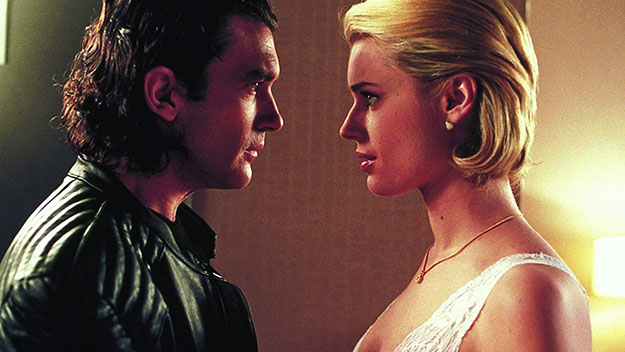
Femme Fatale (Brian De Palma, 2002)
Yet Laure’s not the only one play-acting; in order to gain her confidence, Nicolas, thinking that he’s the one setting the rules of the game, initially poses as a gay man, which he tries to make legible via an unmistakable, effeminate swishiness. Recalling Banderas’s early-career roles for Almodóvar, actor and director are here having a little intertextual fun, though there’s something even more delightful and complicated about this brief passage, calling into question our perception of Laure’s own relationship to her sexuality; was she also posing as gay to get what she wanted? We learn at the end of the film that there is only one character in the film Laure has not double-crossed; crucially, it’s another woman, reconstituting the narrative as even queerer than perhaps we had originally assumed, and revealing Femme Fatale as De Palma’s most sexually fluid movie to date.
As it’s impossible to establish a strict political definition of queerness, whose scholarly application is partly based on an intuitive response from the viewer, a film like Femme Fatale, at once playfully academic in its self-referentiality and coasting gleefully on its viewers’ pure visceral responses, makes for a perfect test case. Laure’s a femme fatale, “rotten to the heart,” as she and Stanwyck both say, but she’s also a brilliant construct who will ultimately take charge of her own destiny, and who on many occasions exerts her power over both men and women by controlling their gaze. As if to underline that she is a cinematic concept as much as a character, De Palma plays extensive tricks—as he so often does—with reality. For large swathes of the film, we find that Laure is quite literally a dream girl. And why not, if movies are dreams, anyway?
Michael Koresky is a writer, editor, and filmmaker in Brooklyn. He is cofounder and editor of the online film magazine Reverse Shot, a publication of Museum of the Moving Image; a regular contributor to the Criterion Collection and Film Comment, where he writes the biweekly column Queer and Now and Then; and the author of Terence Davies, published by University of Illinois Press, 2014.



